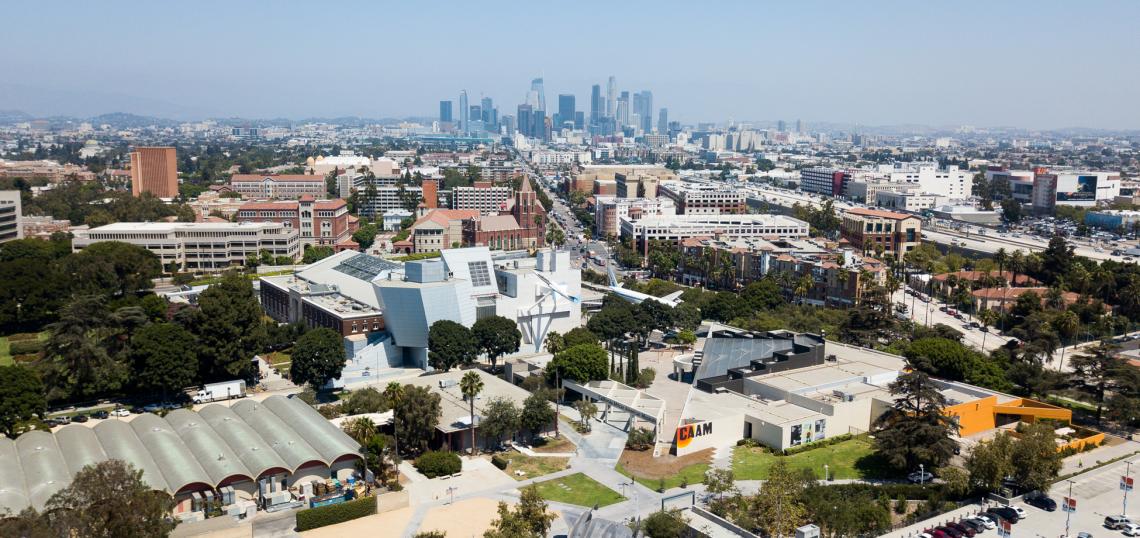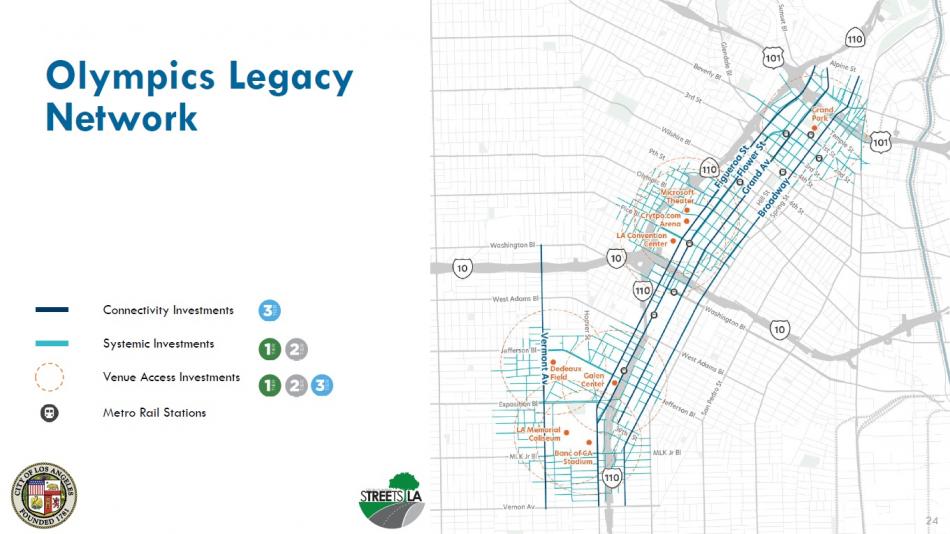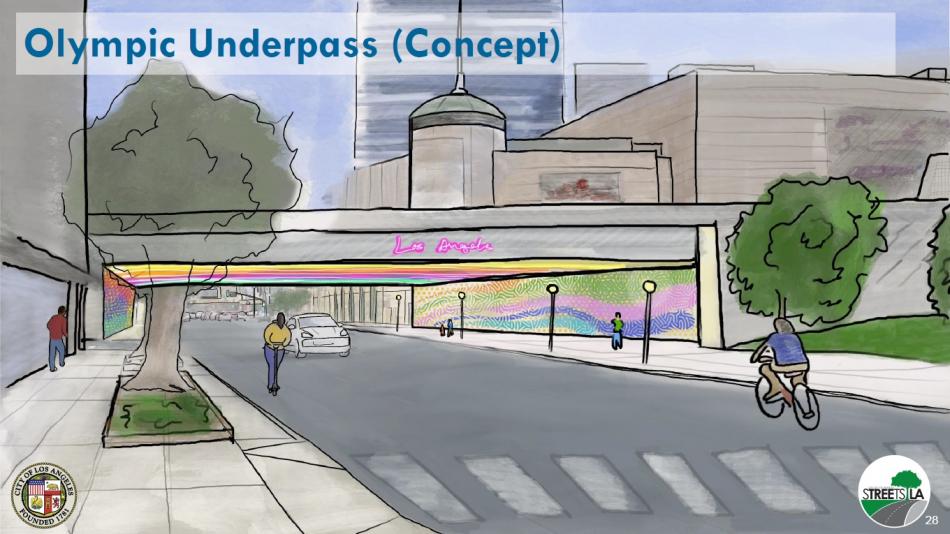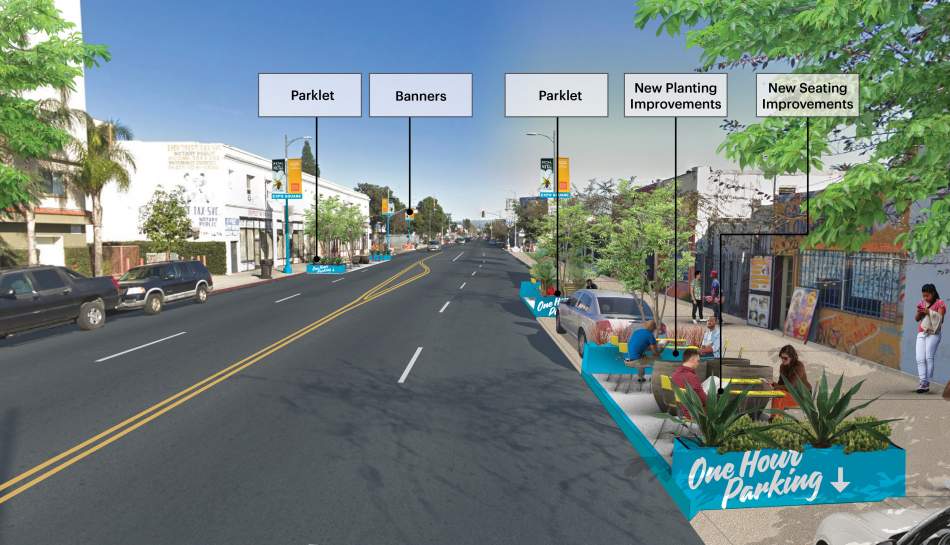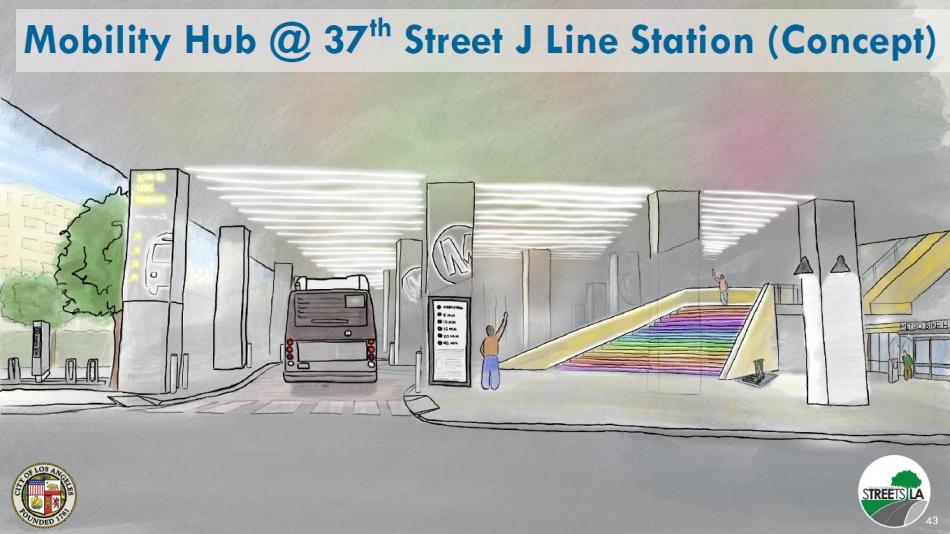The 1984 Los Angeles Summer Olympics are widely regarded as a financial success, having generated a profit which still funds youth sports in Southern California to this day. In a similar vein, public officials have looked to the looming 2028 Olympics as an opportunity to reshape the city's physical infrastructure as a legacy for the games. Metro is pursuing Federal funding for a variety of transportation projects in the lead up to 2028, and a parallel effort undertaken by the City of Los Angeles could bring a targeted array of improvements to the region's core.
The LA 2028 Olympic Legacy Street Improvements Plan was initiated in 2020, when the City's Bureau of Street Services secured grant funding to develop mobility and public realm improvements for the disadvantaged communities which surround event venues in Exposition Park, USC, LA Live, and Grand Park. The results of the more than $600,000 effort were recently detailed in a staff presentation to the Los Angeles City Council's Public Works Committee.
With the help of local community-based organizations and a community advisory committee, staff performed walk audits of key corridors in Downtown, Pico Union, Chinatown, University Park, and Exposition Park, with the goal of identifying current on-the-ground conditions, as well as streets which lack elements such as sidewalks and canopy trees. That led to a list of projects which would be prioritized based on ease of implementation, their potential benefits to visitors during the games in 2028, and their ability to provide permanent benefits to residents afterward.
They are grouped into three categories:
Systemic Improvements
Five specific types of improvements were identified as being most beneficial across the project area: bus shelters, upgrades to freeway underpasses, permanent upgrades to quick-build bike lanes, shade structures, and pavement markings for bikeways.
A key focus was the 47 underpasses within the project area, which were found to have poor lighting, blocked sidewalks, and graffiti. While the region's freeways are unlikely to disappear prior to the return of the Olympics, the report offers suggestions for making them more pleasant to those traveling on foot through the underpasses, including wider sidewalks, the addition of pedestrian-scale lighting, murals and community art, and safety call boxes.
Connectivity
Five north-south corridors which run through the project area were identified as opportunities to improve connectivity for the games, and Los Angeles in the long term: Vermont Avenue, Figueroa Street, Flower Street, Grand Avenue, and Broadway.
In addition to recommending the installation of new pedestrian street lighting, street trees, and bus stop amenities, the plan also considers the potential for Class IV bicycle facilities. Additionally, the recommendations build off of other planning efforts linked to all five corridors.
Along Vermont, the report points to the Reimagining Expo Square plan developed previously by the Planning Department, which could include new crosswalks, landscaping, parklets, and wayfinding signage. Likewise, the plan recommends implementation of the Vermont Avenue Bus Rapid Transit Line, a Measure M project which would connect Exposition Park to several east-west transit lines.
For Figueroa Street, the study recommends building upon the improvements already implemented through the MyFigueroa project, including an extension of existing bus lanes throughout the entire corridor, as well as an upgrade of the current Class II bike lanes to Class IV bike lanes.
On Flower street, recommended improvements include wider sidewalks, in keeping with the requirements of the Downtown Community Plan, as well as the addition of a two-way raised cycle track along the corridor.
Recommendations for Grand Avenue focus on the corridor's existing Class II bikeway, which could be upgraded to a Class IV facility, with addition opportunities for extensions and two-way operations in some stretches.
Finally, the city staff report recommends moving forward with the an already-planned bus rapid transit line along the corridor - a "quick-build" project which has taken longer to implement than originally projected. Additionally, the report recommends implementation of the more then decade-old Broadway Streetscape Master Plan, and potential extensions from its current boundaries north toward Temple Street and south to Martin Luther King Jr. Boulevard.
Venue Access
The final bucket of improvements is focused on access to the venues within the project area, which include Grand Park, Crypto.com Arena, the Galen center, Banc of California Stadium, and the Los Angeles Memorial Coliseum. Recommendations include items such as new crosswalks, wider sidewalks, and the addition of mobility hubs near transit stops. Additionally, the report revives two older concepts: the "Avenue of the Angels" along Francisco Street between the Wilshire Grand and LA Live and plans for grade separation or a second platform at Pico Station, which was originally suggested as a way to increase the passenger capacity during the planning of the cancelled Farmers Field project.
Next Steps
Moving forward, the report indicates that city staff intend to continue work on high-priority projects and pursue additional funding. Those items would include the systemic improvements such as bus shelters, upgrades to freeway underpasses, and bicycle infrastructure, as well as a handful of bigger ticket items. Larger-scale projects considered to have legacy benefits for the 2028 Games include Reimagining Expo Square, the Broadway Streetscape Master Plan, the Vermont BRT Line, and an extension of complete streets improvements along Jefferson Boulevard.
A variety of Federal, State, and local funding sources could be tapped for the projects, although cost estimates will be needed to compete for grants.
Follow us on social media:
- LA2028 (Urbanize LA)




